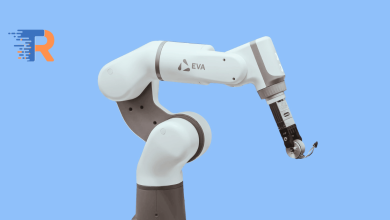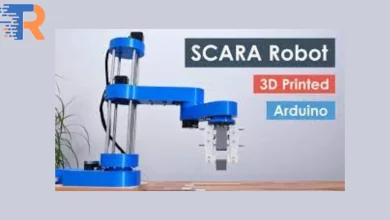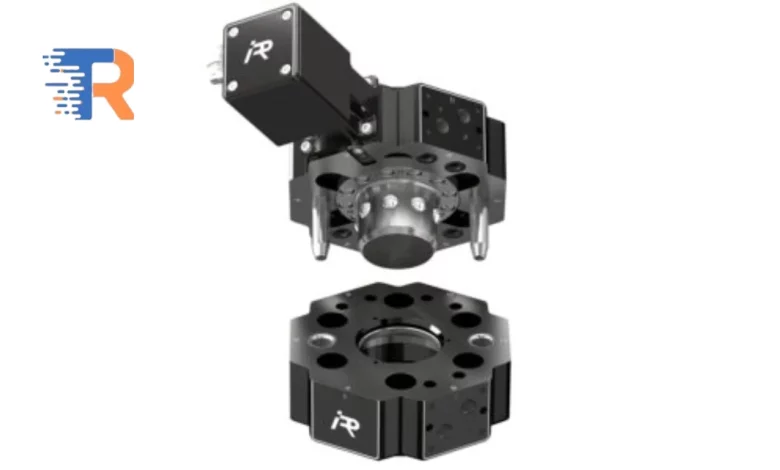
Robots are performing a rising number of manipulation tasks, such as grasping, holding, clamping, screwing, foaming, and welding. FAULHABER understands that flexibility is essential in a variety of industrial processes.
One German company at the top of innovation, FAULHABER, emphasizes the critical importance of flexibility for robotic arms in the constantly changing field of robotics. In a recent blog post, the company delves into the challenges faced by standardized mass production and the pivotal role adaptability plays, particularly in scenarios requiring flexibility, such as batch size 1, ultimately offering potential savings on investment costs.
The Role of Intelligent Peripherals for Robots (IPR):
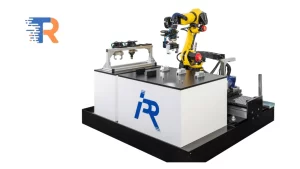 Addressing the demand for adaptability, FAULHABER highlights the Intelligent Peripherals for Robots (IPR) and its innovative solution, the TKX tool changer.
Addressing the demand for adaptability, FAULHABER highlights the Intelligent Peripherals for Robots (IPR) and its innovative solution, the TKX tool changer.
This advanced tool changer, when mounted to the end of a robot arm, revolutionizes the robotic workflow by enabling the removal and interchange of various tools from a rack seamlessly.
The TKX series stands out as a versatile solution that empowers robots to perform a spectrum of tasks, ranging from gripping and positioning a workpiece to processing it with tools, and concluding with quality checks using contour sensors or cameras.
Enhancing Task Range:
- FAULHABER emphasizes that the adaptability provided by the TKX tool changer significantly enhances the range of tasks that a robot can seamlessly carry out.
- In scenarios where standardized mass production falls short, and flexibility becomes a requisite, the TKX series proves invaluable.
- The ability to swiftly switch between different tools allows robots to address diverse tasks efficiently, making it a key player in optimizing operational efficiency in environments that demand flexibility, precision, and versatility.
Versatility and Additional Modules:
- The TKX series from IPR doesn’t just stop at adaptability; it goes a step further by providing options for additional modules.
- With several lateral screw-on surfaces, the tool changer opens doors for integrating supplementary modules, catering to specific task requirements.
- This versatility ensures that the robotic system can be customized and optimized based on the unique needs of different industries and applications.
Securing and Releasing Tools with Precision:
While adaptability is crucial, FAULHABER emphasizes the core functionality of the TKX tool changer: secure locking and quick, consistent release of tools. This aspect is essential to ensure that tools are securely held during operation and can be swiftly interchanged when needed. The accuracy in securing and releasing tools not only contributes to equipped efficiency but also plays a very important role in maintaining the overall consistency and efficiency of robotic arms.
- In the area of robotic arms, where the range of manipulation tasks is constantly expanding, flexibility emerges as a keystone for efficiency.
- FAULHABER’s recognition of this crucial aspect is exemplified through the Intelligent Peripherals for Robots (IPR) and its TKX tool changer.
- By enabling robots to seamlessly switch between tools and perform a diverse array of tasks, the TKX series becomes a key player in enhancing adaptability and efficiency in industrial processes.
As industries evolve and demand flexibility, solutions like the TKX tool changer from FAULHABER pave the way for a future where robotic arms can effortlessly adapt to the dynamic needs of various applications, ultimately driving advancements in automation and manufacturing.
Applications Decide Chose of Pneumatic or Electric
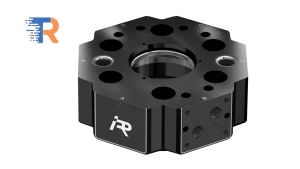 In the realm of industrial applications, the choice between pneumatic and electric power transmissions has long been a crucial decision. FAULHABER, a leading innovator in the field, sheds light on the traditional dominance of pneumatic systems, highlighting their efficacy in handling heavy objects.
In the realm of industrial applications, the choice between pneumatic and electric power transmissions has long been a crucial decision. FAULHABER, a leading innovator in the field, sheds light on the traditional dominance of pneumatic systems, highlighting their efficacy in handling heavy objects.
However, the landscape is evolving, and the selection between pneumatic and electric solutions is increasingly influenced by specific application requirements.
- Pneumatic power transmissions, relying on compressed-air technology, have stood the test of time, particularly in scenarios where handling very heavy objects is paramount.
- However, the inherent complexity of pneumatic systems, requiring compressors, intricate lines, and dedicated control systems with numerous mechanical components, poses a significant investment challenge for new systems.
- While effective, the resource-intensive nature of pneumatics raises questions about its suitability in industries with stringent cleanliness and hygiene standards, such as microelectronics and food processing.
The Hygienic Shift towards Electric Drives:
- Recognizing the limitations of pneumatic systems in environments where cleanliness is non-negotiable, there is a discernible shift towards electric drives, notes IPR, based in Eppingen, Germany.
- The avoidance of compressed air emissions, which are inevitable in pneumatic systems, makes electric drives a more viable option, particularly in clean rooms where pneumatics are an absolute no-go.
- The surge in demand for hygienic safety is complemented by the inherent flexibility of electric motors, offering a versatile solution with power sockets readily available in most locations.
Flexibility and Adaptability:
IPR emphasizes that the trend towards electric drives is not solely driven by hygiene concerns but is also rooted in the flexibility and adaptability offered by electric motors. Unlike the rigid infrastructure required for compressed air connections, electric drives can be seamlessly integrated into existing setups with power sockets available almost anywhere. In newly constructed industrial plants, the preference is shifting away from pneumatic systems, especially in the realm of cobots, smaller robots, and decentralized locations, where the electric alternative proves to be the superior solution.
Read More: Pudu Robotics CEO
Technological Advancements in Electric Drives:
- The viability of electric drives as a real alternative to pneumatics is attributed to significant advancements in motor technology.
- Roman Batz, a development engineer at IPR, highlights the remarkable progress made in recent years.
- The demands of applications, requiring substantial power within compact dimensions, are met by FAULHABER’s motors, which compete favorably with pneumatic drives.
- This progress underscores the newfound feasibility and competitiveness of electric drives in diverse industrial settings.
- The ongoing debate between pneumatic and electric power transmissions in industrial applications is increasingly shaped by the specific demands of each scenario.
- While pneumatic systems continue to excel in handling heavy loads, the surge in industries with stringent cleanliness requirements has tilted the scales towards electric drives.
- The flexibility, adaptability, and technological advancements in electric motor technology position it as a compelling alternative.
As the industrial landscape evolves, the choice between pneumatic and electric solutions becomes not just a matter of tradition but a strategic decision based on the unique demands of each application, ultimately driving innovation and efficiency in the world of industrial automation.
FAULHABER Motors Redefine Automation: Opening, Closing, and Holding with Precision
In the dynamic world of industrial automation, FAULHABER motors stand out as pioneers, redefining the capabilities of robotic systems. Developed by IPR and powered by FAULHABER’s cutting-edge brushless motors, this series is setting new benchmarks in the industry, offering a unique combination of power, efficiency, and adaptability. Particularly, the TKX series, with its most powerful electric model, the TKE 300, is making waves by seamlessly handling the intricate tasks of opening, closing, and holding objects with unparalleled precision.
- Powerful Handling of Heavy Loads
- The motors not only provide ample torque for secure holding but also ensure reliability through the integration of self-retaining kinematics, a proprietary development by IPR.
- The flagship model of the TKX series, the TKE 300, takes the lead in managing substantial loads, boasting the capacity to handle objects weighing up to 300 kg (661.3 lb.), as highlighted by IPR.
- In sectors like metal processing, where robots grapple with hefty cast blocks and large forged parts, the pulling force exerted by their mass is efficiently harnessed by the TKX changer.
Brushless Motors from the FAULHABER BXT Family:
Leveraging external rotor technology, these motors achieve an unparalleled ratio of torque to weight and volume in the market. FAULHABER’s brushless motors from the BXT family serve as the driving force behind the TKX series, excelling in the critical functions of opening, closing, and holding. The outstanding power density is a defining feature of the TKX series, contributing to its unique selling proposition within the realm of tool changers.
Versatility in Drive Types:
- Additionally, a manual version further extends the versatility of the product range.
- This means that the entire spectrum of accessories can be seamlessly used with all drive types without the need for retooling.
- Roman Batz, a development engineer at IPR, emphasizes the groundbreaking aspect of the TKX series being the first tool changers available on the market with both pneumatic and electric drives.
- The ease of transitioning to electric operation unlocks new possibilities for robotic automation, heralding a paradigm shift in the way industrial processes are approached.
- FAULHABER’s motors, in collaboration with IPR’s innovative TKX series, are rewriting the narrative of robotic automation.
- The precision in opening, closing, and holding tasks, coupled with the capacity to handle substantial loads, marks a significant leap forward in the capabilities of robotic systems.
- The strategic integration of FAULHABER’s brushless motors not only ensures powerful and reliable performance but also positions the TKX series as a pioneering solution with unmatched power density.
- As industries embrace this trans-formative technology, the TKX series heralds a new era of efficiency, adaptability, and precision in industrial automation, where the boundaries of what robotic systems can achieve are continually pushed and redefined.
Components Designed to be Reliable, Easy to Combine
In the fast-paced world of industrial automation, precision, reliability, and adaptability are paramount. IPR’s TKE changers, a testament to cutting-edge engineering, promise a transformative approach to handling work pieces. With seven sizes catering to a weight range from 3 to 300 kg (6.6 to 661.3 lb.), this product family, available in an electric variant, opens up a wide array of applications, spanning from lightweight robots to stationary setups.
As the driving force behind these changes, FAULHABER’s BXT motors step into the spotlight, offering not just power but a seamless integration of quality and performance.
- IPR’s TKE changers distinguish themselves by offering a comprehensive range of sizes, ensuring that there’s a perfect fit for handling workpieces across various industries.
- The versatility extends from lighter applications with smaller workpieces to robust handling capabilities for larger loads.
- Roman Batz, a development engineer at IPR, emphasizes the importance of this range, indicating that the ability of robots to achieve seven-digit cycle numbers without maintenance was a crucial criterion in the design process.
- Ensuring the efficiency and longevity of robotic systems, IPR meticulously adapts the dimensions of the BXT motors to suit specific applications.
- This tailored approach is complemented by a diverse selection of gears, strategically chosen for optimal reduction in each case.
- The result is a harmonious integration of components, providing robots with the precision and reliability required for extensive cycles without the need for frequent maintenance.
- Batz underlines the necessity of employing brushless motors with the highest possible processing quality to meet the rigorous demands of industrial applications.
- FAULHABER’s BXT motors fit this criterion seamlessly, offering not just power but a level of processing quality that ensures longevity and consistent performance.
- The brushless design minimizes wear and tear, making them ideal for achieving extended operational cycles without compromising reliability.
- Managing the speed of robotic systems is a critical aspect of industrial automation.
- The TKE changers address this challenge by incorporating an integrated speed controller.
- This feature not only streamlines the control process but also enhances the overall manageability of the components.
- The seamless integration of speed control ensures that the TKE changers operate with precision and efficiency, meeting the dynamic requirements of diverse industrial settings.
- Industrial environments can often subject components to extreme conditions.
- TKE changers, powered by FAULHABER’s BXT motors, are built to withstand temperatures of up to +80°C.
- This robust construction ensures that the components retain their performance integrity even in challenging thermal conditions, adding an extra layer of reliability to the overall system.
- IPR’s journey with FAULHABER dates back many years, emphasizing the enduring partnership built on trust and quality.
- Batz acknowledges the unique quality of FAULHABER’s micromotors and highlights the importance of the multifaceted aspects that contribute to this successful collaboration.
IPR’s TKE changers, powered by FAULHABER’s BXT motors, emerge as a cornerstone in the realm of industrial automation. The meticulous design, tailored dimensions, and integration of cutting-edge components ensure not just power but a holistic approach to precision, reliability, and adaptability.
As industries evolve, seeking solutions that can seamlessly handle diverse work pieces and operational demands, the TKE changers stand ready to redefine the landscape of industrial automation. This innovative product family is not just a testament to engineering excellence but a catalyst for pushing the boundaries of what robotic systems can achieve in the dynamic and demanding world of modern manufacturing.

